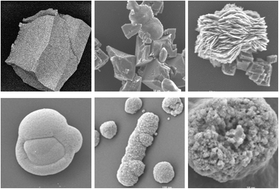Calcium carbonate crystallization in tailored constrained environments
Abstract
Synthesis of inorganic particles using routes inspired by biomineralization is a goal of growing interest. Recently it was demonstrated that the size and geometry of crystallization sites are as important as the structure of charged templating surfaces to obtain particles with controlled features. Most biominerals are formed inside restricted, constrained or confined spaces where at least parts of the boundaries are cell membranes containing phospholipids. In this study, we used a gas diffusion method to determine the effect of different lecithin media on the crystallization of CaCO3 and to evaluate the influence of the spatial arrangement of lecithin molecules on templating CaCO3 crystal formation. By using inorganic synthesis, Raman spectroscopy, dynamic light scattering, electrochemical methods and scanning electron microscopy, we showed that the occurrence of surface-modified calcite crystals and diverse textured vaterite crystals reflects the geometry and spatial distribution of aqueous constrained spaces due to the lecithin assembly controlled by lecithin concentration in an ionized calcium chloride solution under a continuous CO2 diffusion atmosphere. This research shows that by tailoring the assembly of lecithin molecules, as micelles or reversed micelles, it is possible to modulate the texture, polymorphism, size and shape of calcium carbonate crystals.


 Please wait while we load your content...
Please wait while we load your content...